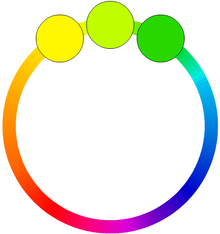Analogous colors

In color theory, analogous colors are groups of colors that are next to each other on the color wheel. Red, orange, and red-orange are examples.
The term analogous refers to having analogy, or corresponding to something in particular. This color scheme strength comes to the fact that it lacks contrast as in comparison to its counterpart, the complementary schemes.[citation needed]

Application
These color schemes are most often seen in nature. For example, during the fall, one might often see the changing leaves form an analogous sort of color scheme, progressively moving through the color wheel to create a gradient in its natural pattern.
High-key analogous
High-key color schemes have a lighter value, having white added to them or water in the case of watercolors. These have a more pastel-like look to them. Having a high-key analogous color scheme can give a piece a stimulating shimmer that pleases the eye, making everything seem the same color at first until approach. The colors are pure and aren't affected by their complements which grab attention. This was commonly used in impressionism by artists such as Monet, Pissarro, and Degas. Pierre Bonnard has also been noted for using it.
Footnotes
References
- "Basic Color Schemes: Color Theory Introduction". Color Schemes Made Easy. TigerMedia. Archived from the original on April 30, 2015. Retrieved December 4, 2011.
- "Color Wheel Pro: Classic Color Schemes". Color Wheel Pro: See Color Theory in Action!. Color Wheel Pr. Retrieved December 4, 2011.
- "Basic Color Theory". Color Matters Welcomes You to the World of Color: Symbolism, Design, Vision, Science, Marketing and More!. Color Matters. November 22, 1995. Retrieved December 4, 2011.
- "Combining Colors - Analog, Complementary, Triad - Colors on the Web". Color Theory, Color Wheel and Combining Colors, Colors on the Web. Colors on the Web. 1998. Retrieved December 4, 2011.
- Appellof, Marian (1994). "A High Key Analogous Color Scheme". Everything You Ever Wanted to Know About Watercolor. New York: Watson-Guptill. p. 57.
- Bleicher, Steven (2011). "Color Harmonies". Contemporary Color: Theory & Use. Clifton Park. NY: Delmar Cengage Learning. p. 70.
- Lauer, David; Pentak, Stephen (2010). "Analogous Color Scheme". Design Basics (8th ed.). Australia: Cengage. p. 279.
